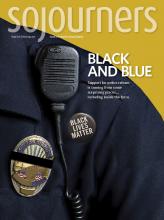DAN ZAK WAS FIRST struck by the absurdity of it all. As a reporter for The Washington Post, he was fascinated to learn that Sister Megan Rice, Michael Walli, and Greg Boertje-Obed had crossed forested hills in the middle of the night in Oak Ridge, Tenn., and reached the center of a government complex where possibly the most dangerous material in the world is enriched and stored.
Then Zak was captured by what was behind their action—the dramatic secrecy in the development of the first atomic bomb, the tragedy of its testing on U.S. soldiers and on the unsuspecting inhabitants of the Marshall Islands, the bungling bureaucracy surrounding the entire nuclear industry, and finally the hope and resilience of the resisters who work to eliminate these perilous weapons. His book Almighty: Courage, Resistance, and Existential Peril in the Nuclear Age (Blue Rider Press) is the result.
Rice, Walli, and Boertje-Obed called their action the Transform Now Plowshares, following a tradition of serious faith-inspired nonviolent actions dating back to 1980, actions often successful in reaching their nuclear targets and resulting in prison terms.
In July 2012, the trio cut through several fences—aided by malfunctioning motion sensors—at times moving through bright floodlight and past signs warning, “Deadly force authorized.” They hung a banner on one fence that proclaimed the words that were the source of their action, the injunction from Isaiah to “hammer their swords into plowshares and their spears into pruning hooks” (2:4).
They arrived at Y-12, a building that stores 800,000 pounds of weapons-grade uranium, the material that undergoes fusion when a nuclear bomb is detonated. Using traditional Plowshares action symbols, they streaked the white walls with the blood of activists, spurted from baby bottles they carried in their backpacks. They painted the building with the phrases “Woe to the empire of blood” and “The fruit of justice is peace.” They chipped away at the concrete walls with small hammers, and they waited.
Read the Full Article

